Themed collection Polymer Upcycling

Introduction to Polymer Upcycling
Blair Brettmann, Marco A. Fraga, Monika Gosecka and Natalie Stingelin introduce the cross journal themed collection on Polymer Upcycling.

J. Mater. Chem. A, 2023,11, 5975-5977
https://doi.org/10.1039/D3TA90040A
Recent development of end-of-life strategies for plastic in industry and academia: bridging their gap for future deployment
Bridging the gap between academia and industry in plastic recycling will accelerate innovation and deployment toward solving the global challenge of plastic waste management and establishing net zero carbon society.
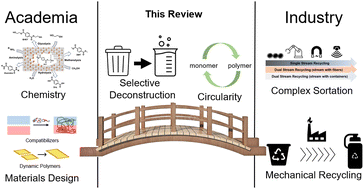
Mater. Horiz., 2023,10, 1608-1624
https://doi.org/10.1039/D2MH01549H
Catalytic routes towards polystyrene recycling
This minireview focuses on potential catalytic recycling processes for the production of styrene and other valuable aromatics from polystyrene (PS) waste, and it aims to lay the ground for PS recyclability and long-term sustainable PS production.
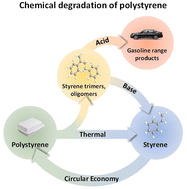
Mater. Horiz., 2023,10, 1625-1640
https://doi.org/10.1039/D2MH01215D
Upcycling of thermosetting polymers into high-value materials
The strategies implemented for upcycling thermoset waste are first reviewed, followed by their strengths and weaknesses; lastly, future directions are highlighted.

Mater. Horiz., 2023,10, 41-51
https://doi.org/10.1039/D2MH01128J
Synthesis and thermomechanical properties of bioplastics and biocomposites: a systematic review
Materials research relating to bio-based polymers and composites has become the order of the day and several types of research are being undertaken on these materials.

J. Mater. Chem. B, 2023,11, 3307-3337
https://doi.org/10.1039/D2TB02221D
State of the art in the photochemical degradation of (micro)plastics: from fundamental principles to catalysts and applications
Plastics and microplastics are major environmental pollutants due to wide applications and difficult degradations. Herein, we summarize several studies on degradations of (micro)plastics to value-added products and intermediates via photocatalysis.

J. Mater. Chem. A, 2023,11, 2503-2527
https://doi.org/10.1039/D2TA09523H
Controlling selectivity for dechlorination of poly(vinyl chloride) with (xantphos)RhCl
Reactions of poly(vinyl chloride) (PVC) with a rhodium catalyst and H-donors reveal how reaction conditions can impact the selectivity for chloride removal, with sodium formate showing the highest selectivity for hydrodechlorination.

Mater. Horiz., 2023,10, 2047-2052
https://doi.org/10.1039/D2MH01293F
Recyclable thermosets based on modified epoxy-amine network polymers
A simple, single stage process is reported for the creation of a recyclable thermoset material from readily available epoxy resins and aliphatic amines, crosslinked with diboronic esters.
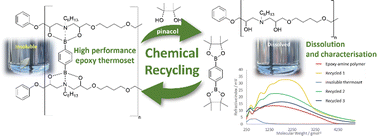
Mater. Horiz., 2023,10, 889-898
https://doi.org/10.1039/D2MH01211A
Divergent silylium catalysis enables facile poly(vinyl chloride) upcycling to poly(ethylene-co-styrene) derivatives
Tandem hydrodechlorination/Friedel–Crafts alkylation of poly(vinyl chloride) (PVC) is achieved using silylium ion catalysts to prepare new styrenic copolymers of polyethylene.

J. Mater. Chem. A, 2023,11, 2128-2132
https://doi.org/10.1039/D2TA08142C
Waste PET upcycling to conductive carbon-based composite through laser-assisted carbonization of UiO-66
The upcycling of waste polymers into novel materials with high added value is a vital task for modern chemical engineering.

J. Mater. Chem. A, 2023,11, 1108-1115
https://doi.org/10.1039/D2TA08127J
Upcycling waste poly(ethylene terephthalate) into polymer electrolytes
The first working lithium-ion battery containing polymer electrolytes derived from waste poly(ethylene terephthalate) beverage bottles is demonstrated.
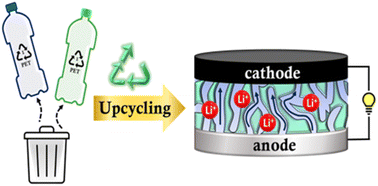
J. Mater. Chem. A, 2022,10, 24468-24474
https://doi.org/10.1039/D2TA06692K
Exploiting valuable supramolecular materials from waste plastics
Chemical upcycling of plastic wastes into a new low-molecular-weight supramolecular adhesive with excellent performances.
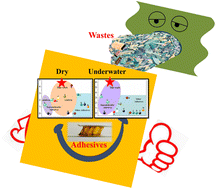
Mater. Horiz., 2022,9, 2993-3001
https://doi.org/10.1039/D2MH00781A
Modulating oxygen vacancy concentration on Bi4V2O11 nanorods for synergistic photo-driven plastic waste oxidation and CO2 reduction
Synergistic photo-driven plastic waste oxidation and CO2 reduction on Bi4V2O11 nanorods with abundant oxygen vacancies.
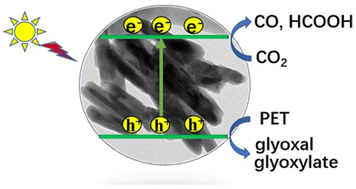
J. Mater. Chem. A, 2023,11, 12770-12776
https://doi.org/10.1039/D2TA09345F
Highly tough, degradable, and water-resistant bio-based supramolecular plastics comprised of cellulose and tannic acid
Bio-based degradable supramolecular plastics with a high fracture strength of 265 MPa and excellent water-resistance are fabricated through complexation of regenerated cellulose with tannic acid, and can be fully degraded under soil in ∼35 days.

J. Mater. Chem. A, 2023,11, 7193-7200
https://doi.org/10.1039/D3TA00351E
The structural evolution of poly(ethylene terephthalate) oligomers produced via glycolysis depolymerization
Polymeric materials have become an integral part of our society, and their high demand has created a large quantity of polymers that end up in the waste stream.

J. Mater. Chem. A, 2023,11, 4679-4690
https://doi.org/10.1039/D2TA07467B
Synthesis of platinum nanoparticles on strontium titanate nanocuboids via surface organometallic grafting for the catalytic hydrogenolysis of plastic waste
Pt/SrTiO3 nanoparticle catalysts have been synthesized by surface organometallic chemistry in solution on a 5 g scale. Pt/SrTiO3 selectively and repeatedly upcycles isotactic polypropylene into uniform liquid products with Mn ∼ 200 Da.
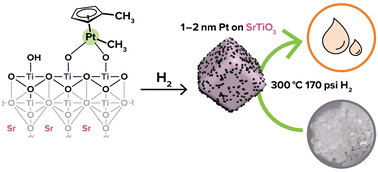
J. Mater. Chem. A, 2023,11, 1216-1231
https://doi.org/10.1039/D2TA08133D
Bifunctional heterogeneous catalysts from biomass and waste polysaccharides for the conversion of CO2 into cyclic carbonates
A four-step method was applied to biomass and waste polysaccharides, obtaining char-based bifunctional catalysts active in CO2 conversion into cyclic carbonates.
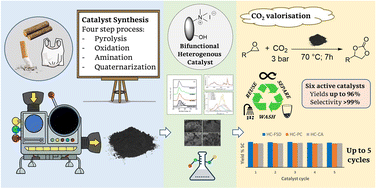
J. Mater. Chem. A, 2023,11, 775-788
https://doi.org/10.1039/D2TA05906A
A strategy to enhance recyclability of degradable block copolymers by introducing low-temperature formability
Block copolymers composed of poly(trimethylene carbonate) and polylactide can be processed at ambient temperature under pressure by a reversible pressure-induced phase transition between an ordered (solid) state and a disordered (melt/solid) state.

J. Mater. Chem. A, 2022,10, 25446-25452
https://doi.org/10.1039/D2TA06036A
Biobased catalyst-free covalent adaptable networks based on CF3-activated synergistic aza-Michael exchange and transesterification
This study reports the synthesis and characterization of biobased CANs incorporating CF3-activated aza-Michael bonds and ester groups showing remarkable reprocessing abilities and high activation energy.
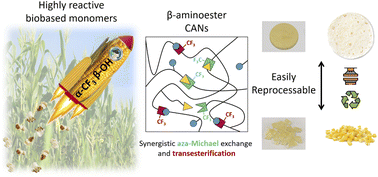
J. Mater. Chem. A, 2022,10, 25085-25097
https://doi.org/10.1039/D2TA05067F
Simple upcycling of virgin and waste polyethylene into covalent adaptable networks: catalyst-free, radical-based reactive processing with dialkylamino disulfide bonds
For the first time, virgin and waste polyethylene (PE) was upcycled using exclusively free-radical methods into reprocessable, thermally stable, and creep-resistant PE covalent adaptable networks capable of dialkylamino disulfide dynamic chemistry.

J. Mater. Chem. A, 2022,10, 24726-24745
https://doi.org/10.1039/D2TA06364F
Population balance models for polymer upcycling: signatures of the mechanism in the molecular weight evolution
Chemical and catalytic upcycling processes could help realize a circular plastics economy, but current models for testing mechanistic hypotheses and designing catalysts remain primitive.

J. Mater. Chem. A, 2022,10, 24084-24095
https://doi.org/10.1039/D2TA04628H
Recyclable optical bioplastics platform for solid state red light harvesting via triplet–triplet annihilation photon upconversion
Sustainable red light harvesting has been achieved in recyclable protein–surfactant–chromophores co-assembled bioplastics with high efficiency due to the efficient diffusion of triplet excited chromophores, and oxygen blockage by protein fibers.
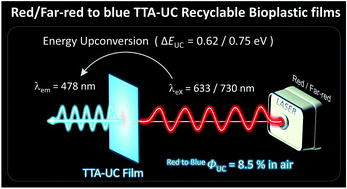
J. Mater. Chem. A, 2022,10, 21279-21290
https://doi.org/10.1039/D2TA04810H
Integrating recyclable polymers into thermoelectric devices for green electronics
Electronic waste (e-waste) recycling is one of the central frameworks of the circular economy.
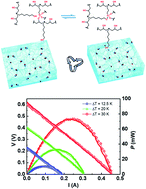
J. Mater. Chem. A, 2022,10, 19787-19796
https://doi.org/10.1039/D2TA00386D
About this collection
In 2015 alone, the global waste generated by plastic packaging applications was 82.7 metric tons (Mt). Currently, waste management practices for the end-of-life plastics exploit landfilling, industrial energy recovery from municipal solid waste incineration, pyrolysis and recycling. Due to the ubiquity and necessity of plastics in our daily life, the elimination or reduction of plastics is not foreseeable in the near future and fundamentally new science is needed to describe and understand the polymers, interfaces, decomposition and upcycling of plastics.
Guest Edited by Dr Blair Brettmann (Georgia Institute of Technology), Prof. Marco Fraga (Instituto Nacional De Technologia Brasil), Dr Monika Gosecka (Polish Academy of Sciences) and Prof. Natalie Stingelin (Georgia Institute of Technology), this themed collection on ‘Polymer Upcycling’ across Materials Horizons, Journal of Materials Chemistry A and Journal of Materials Chemistry B aims to explore the latest developments in materials characterization, polymer design and synthesis, physical chemistry and molecular understanding of plastic decomposition and transformation that contribute to a broad knowledge base for upcycling waste plastics.
We hope this collection provides some insight into current research related to polymer upcycling with application in mitigating the global plastic waste challenges.
If you are interested in this collection, why not read this related collection across Polymer Chemistry and Catalysis Science & Technology on ‘Plastic Conversion’. This collection aims to highlight research that makes use of catalysis to optimise plastic recycling and addresses getting the most out of plastic waste.